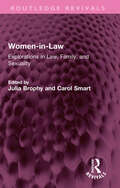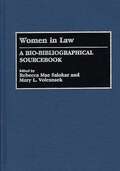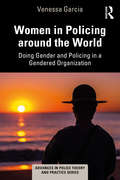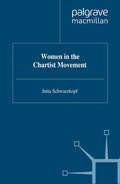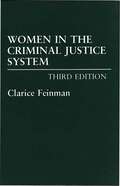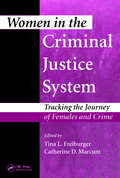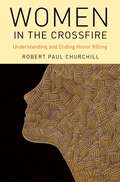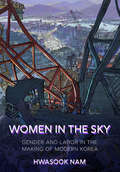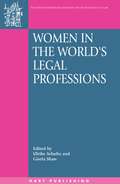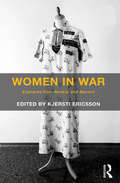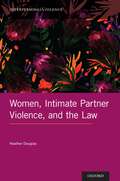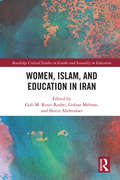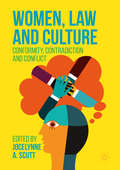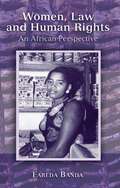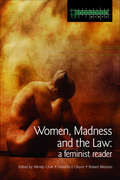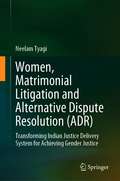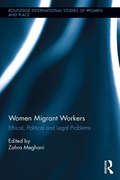- Table View
- List View
Women-in-Law: Explorations in Law, Family, and Sexuality (Routledge Revivals)
by Julia Brophy Carol SmartFirst published in 1985, Women-in-Law is a collection of essays examining the complex interactions of law, sexuality, and the family. It explores the ways in which legal ideology and practice affect women and looks at issues such as child custody, domestic violence and prostitution in the light of new research. The contributors review the history of feminist involvement with the law and analyse the law’s fundamental failure to improve the status of women. They also assess strategies for change in view of the current backlash against women’s rights and the traditional role of law in the subjugation of women. This book will be of interest to students of law, political science, sociology, gender studies, and sexuality studies.
Women-in-Law: Explorations in Law, Family, and Sexuality (Routledge Revivals)
by Julia Brophy Carol SmartFirst published in 1985, Women-in-Law is a collection of essays examining the complex interactions of law, sexuality, and the family. It explores the ways in which legal ideology and practice affect women and looks at issues such as child custody, domestic violence and prostitution in the light of new research. The contributors review the history of feminist involvement with the law and analyse the law’s fundamental failure to improve the status of women. They also assess strategies for change in view of the current backlash against women’s rights and the traditional role of law in the subjugation of women. This book will be of interest to students of law, political science, sociology, gender studies, and sexuality studies.
Women in Law: A Bio-Bibliographical Sourcebook
by Rebecca M. Salokar Mary VolcansekForty-three women who have made major contributions to the law through their work in the legal profession, scholarly legal research, and political activism directed at socio-legal reforms are profiled in this bio-bibliographical sourcebook. The women featured are from countries and regions with a Western legal tradition, including North America, Europe, Israel, Japan, the Philippines, and Africa. Each profile contains extended biographical information and details significant achievements and contributions to the law made by each woman, followed by references.Forty-three women who have made major contributions to the law through their work in the legal profession, scholarly legal research, and political activism directed at socio-legal reforms are profiled in this bio-bibliographical sourcebook. The women featured are from countries and regions with a Western legal tradition, including North America, Europe, Israel, Japan, the Philippines, and Africa. Each profile contains extended biographical information—their family backgrounds, education, and career development—and their significant achievements and contributions to law. The women featured include a number of those who were path-breakers like Sandra Day O'Connor, the first woman justice of the U.S. Supreme Court, and Bertha Wilson, the first woman to sit on the Canadian Supreme Court. Scholars like Margaret Somerville (Canada) and Beverly Blair Cook (U.S.), and political activists like Helene St^Docker (Germany) and Leah Tsemel (Israel) are also included. The introduction to the work presents a comprehensive and historical overview of the role of women as citizens, scholars, lawyers, judges, office holders, and activists, and also provides a review of the scholarship on women in law.
Women in Policing around the World: Doing Gender and Policing in a Gendered Organization (Advances in Police Theory and Practice)
by Venessa GarciaWomen in Policing around the World is a historical, legal, political, and social examination of women in policing. The book opens with a comparison of cultural definitions of gender and how this affects women’s work in general and policing specifically. The book then takes the reader through women in policing in the Eastern and Western Hemispheres, featuring several countries within the major regions of the world. Major commonalities and differences are identified in the areas of recruitment, training, deployment, promotion, and violence against women. Among the key features of this book is a balanced coverage of historical and timely events that led to the current status of women police in their respective countries. The book identifies the commonalities that women police experience throughout the world, relying on the most current research. The book also dedicates coverage of policing violence against women in society as well as within the police organization itself. The author includes tables to allow for national comparisons throughout the book, as well as current and historical photos. This book is intended for researchers and students of police culture and women in policing. It does not rely heavily on one country or region, thus allowing for an enlightening international comparison.
Women in Policing around the World: Doing Gender and Policing in a Gendered Organization (Advances in Police Theory and Practice)
by Venessa GarciaWomen in Policing around the World is a historical, legal, political, and social examination of women in policing. The book opens with a comparison of cultural definitions of gender and how this affects women’s work in general and policing specifically. The book then takes the reader through women in policing in the Eastern and Western Hemispheres, featuring several countries within the major regions of the world. Major commonalities and differences are identified in the areas of recruitment, training, deployment, promotion, and violence against women. Among the key features of this book is a balanced coverage of historical and timely events that led to the current status of women police in their respective countries. The book identifies the commonalities that women police experience throughout the world, relying on the most current research. The book also dedicates coverage of policing violence against women in society as well as within the police organization itself. The author includes tables to allow for national comparisons throughout the book, as well as current and historical photos. This book is intended for researchers and students of police culture and women in policing. It does not rely heavily on one country or region, thus allowing for an enlightening international comparison.
Women in the Chartist Movement (Studies in Gender History)
by J. SchwarzkopfTowards the end of the 1830s, large numbers of British working men and women rallied round the People's Charter in order to improve their living conditions through universal suffrage. Women's wide-ranging support of Chartism encompassed everything from extensive lecturing tours to domestic servicing of politically active menfolk. In this first full-length study of women's involvement in Chartism, the author demonstrates that, in their struggle, which lasted for more than a decade, Chartist men and women enforced in their own ranks standards of respectable man- and womanhood that were to shape working-class gender relations well into this century.
Women in the Criminal Justice System: Third Edition
by Clarice FeinmanThis third edition provides thoroughly updated information on the status of women in all aspects of the U.S. criminal justice system, from incarcerated women to professionals in the legal, law enforcement, and correctional fields. While concentrating on the present, Clarice Feinman traces changes in theories, goals, practices, and policies concerning women of different racial, ethnic, and socioeconomic backgrounds--be they offenders, professionals, or reformers--since 1800, with a focus on why changes occurred. This unique text is an important tool for filling gaps in information, continuity, and understanding of issues affecting women in the up-hill battle to transform this male-dominated system.
Women in the Criminal Justice System: Tracking the Journey of Females and Crime
by Catherine D. Marcum Tina L. FreiburgerThis book provides a rare up-to-date examination of women both as offenders and employees in the criminal justice system. It presents the current state of females in the system through contributions by expert authors. It discusses the criminal justice system‘s reaction to women, as well as the successes and failures of its responses and current and future consequences. It outlines the history of women in the context of the criminal justice system, discusses specific women‘s issues in focused chapters, and highlights key concepts, statistics, and legislation. Each chapter ends with discussion questions to enhance understanding.
Women in the Criminal Justice System: Tracking the Journey of Females and Crime
by Catherine D. Marcum Tina L. FreiburgerThis book provides a rare up-to-date examination of women both as offenders and employees in the criminal justice system. It presents the current state of females in the system through contributions by expert authors. It discusses the criminal justice system‘s reaction to women, as well as the successes and failures of its responses and current and future consequences. It outlines the history of women in the context of the criminal justice system, discusses specific women‘s issues in focused chapters, and highlights key concepts, statistics, and legislation. Each chapter ends with discussion questions to enhance understanding.
Women in the Crossfire: Understanding and Ending Honor Killing
by Robert Paul ChurchillEvery year, thousands of girls and women die at the hands of blood relatives. These victims are accused of committing honor violations that bring shame upon their families: such 'transgressions' range from walking with a boy in their neighborhood to seeking to marry a man of their own choosing, to being a victim of rape. Women in the Crossfire presents a thorough examination of honor killing, an ages-old social practice through which women are trapped and subjected to terror and deadly violence as consequences of the evolution of dysfunctional patriarchal structures and competition among men for domination. To understand the practice of honor killing, its root causes, and possibilities for protection and prevention, Robert Paul Churchill considers the issues from a variety of perspectives: epistemic, anthropological, sociological, cultural, ethical, historical, and psychological. He makes use of original research by analyzing a database of honor killing cases, published here for the first time. Specifically, Women in the Crossfire addresses the salient traits and trends present in honor killing incidents and examines how honor is understood in socio-cultural contexts where these killings occur. The book aims to illuminate causal pathways that combine to produce the tragedy of honor killing. Socialization within honor-shame cultures, factors such as gender construction, child-rearing practices, and adverse experiences prime boys and men to take roles as one-day killers of sisters, daughters, and wives in the name of honor. The book further relies on theories of cultural evolution to explain how honor killing was an adaptation to specific ecological challenges and co-evolved with other patriarchic institutions. The ultimate aim of Women in the Crossfire is to convey promising methods of preventing future honor killings, and to protect girls and women from victimization.
Women in the Crossfire: Understanding and Ending Honor Killing
by Robert Paul ChurchillEvery year, thousands of girls and women die at the hands of blood relatives. These victims are accused of committing honor violations that bring shame upon their families: such 'transgressions' range from walking with a boy in their neighborhood to seeking to marry a man of their own choosing, to being a victim of rape. Women in the Crossfire presents a thorough examination of honor killing, an ages-old social practice through which women are trapped and subjected to terror and deadly violence as consequences of the evolution of dysfunctional patriarchal structures and competition among men for domination. To understand the practice of honor killing, its root causes, and possibilities for protection and prevention, Robert Paul Churchill considers the issues from a variety of perspectives: epistemic, anthropological, sociological, cultural, ethical, historical, and psychological. He makes use of original research by analyzing a database of honor killing cases, published here for the first time. Specifically, Women in the Crossfire addresses the salient traits and trends present in honor killing incidents and examines how honor is understood in socio-cultural contexts where these killings occur. The book aims to illuminate causal pathways that combine to produce the tragedy of honor killing. Socialization within honor-shame cultures, factors such as gender construction, child-rearing practices, and adverse experiences prime boys and men to take roles as one-day killers of sisters, daughters, and wives in the name of honor. The book further relies on theories of cultural evolution to explain how honor killing was an adaptation to specific ecological challenges and co-evolved with other patriarchic institutions. The ultimate aim of Women in the Crossfire is to convey promising methods of preventing future honor killings, and to protect girls and women from victimization.
Women in the Sky: Gender and Labor in the Making of Modern Korea
by Hwasook NamWomen in the Sky examines Korean women factory workers' century-long activism, from the 1920s to the present, with a focus on gender politics both in the labor movement and in the larger society. It highlights several key moments in colonial and postcolonial Korean history when factory women commanded the attention of the wider public, including the early-1930s rubber shoe workers' general strike in Pyongyang, the early-1950s textile workers' struggle in South Korea, the 1970s democratic union movement led by female factory workers, and women workers' activism against neoliberal restructuring in recent decades. Hwasook Nam asks why women workers in South Korea have been relegated to the periphery in activist and mainstream narratives despite a century of persistent militant struggle and indisputable contributions to the labor movement and successful democracy movement. Women in the Sky opens and closes with stories of high-altitude sit-ins—a phenomenon unique to South Korea—beginning with the rubber shoe worker Kang Churyong's sit-in in 1931 and ending with numerous others in today's South Korean labor movement, including that of Kim Jin-Sook.In Women in the Sky, Nam seeks to understand and rectify the vast gap between the crucial roles women industrial workers played in the process of Korea's modernization and their relative invisibility as key players in social and historical narratives. By using gender and class as analytical categories, Nam presents a comprehensive study and rethinking of the twentieth-century nation-building history of Korea through the lens of female industrial worker activism.
Women in the World's Legal Professions (Oñati International Series in Law and Society)
by Ulrike Schultz Gisela ShawWomen lawyers,less than a century ago still almost a contradiction in terms, have come to stay. Who are they? Where are they? What impact have they had on the profession that had for so long been a bastion of male domination? These are key questions asked in this first comprehensive study of women in the world's legal professions. Answers are based on both quantitative and qualitative analyses, using a variety of conceptual frameworks. 26 contributions by 25 authors present and evaluate the situation of women in the legal profession in both common and civil law countries in the developed world. 15 countries from four continents are covered: the United States of America, Canada, Australia, New Zealand, England, Israel, Germany, the Netherlands, Poland, Finland, France, Italy, Brazil, Korea, and Japan. The focus ranges from judges and public prosecutors, to law professors, lawyers (attorneys), notaries and company lawyers. National differences are clearly in evidence, but so are common features cutting across national boundaries. Experience of glass ceilings and revolving doors is as widespread and as real as success stories of women lawyers pursuing their own projects.
Women in War: Examples from Norway and Beyond
by Kjersti EricssonThis book examines what happens to women and gender relations in times of upheaval. The experience of Norway during World War II, with some visits to other parts of the world as well, is used to demonstrate general, gendered issues that are actualized in wars both past and present. The authors explore whether gendered cultural conceptions influence the way war is remembered and represented, both collectively and individually. The collection discusses the various roles of women during the war from resistance fighter to `German tart’ and how they were dealt with and treated in the aftermath. The chapters examine the position of Jewish victims of persecution, foreign female labourers and gay men, as well as the gendered response exhibited by the courts in post-war trials of female state police employees. The book concludes by following the struggle to bring women’s role in war and peacebuilding onto the international agenda. This book will be of interest to students and scholars in the field of criminology, as well as peace and conflict studies, political science, sociology of law, history, social work, social pedagogy, psychology and gender studies.
Women in War: Examples from Norway and Beyond
by Kjersti EricssonThis book examines what happens to women and gender relations in times of upheaval. The experience of Norway during World War II, with some visits to other parts of the world as well, is used to demonstrate general, gendered issues that are actualized in wars both past and present. The authors explore whether gendered cultural conceptions influence the way war is remembered and represented, both collectively and individually. The collection discusses the various roles of women during the war from resistance fighter to `German tart’ and how they were dealt with and treated in the aftermath. The chapters examine the position of Jewish victims of persecution, foreign female labourers and gay men, as well as the gendered response exhibited by the courts in post-war trials of female state police employees. The book concludes by following the struggle to bring women’s role in war and peacebuilding onto the international agenda. This book will be of interest to students and scholars in the field of criminology, as well as peace and conflict studies, political science, sociology of law, history, social work, social pedagogy, psychology and gender studies.
Women, Intimate Partner Violence, and the Law (Interpersonal Violence)
by Heather DouglasEvery year, millions of women across the world turn to the law to help them live free from intimate partner violence. They engage with child protection services and police and apply for civil protection orders. They seek family court orders to keep their children safe from violent fathers, and take special visa pathways to avoid deportation following their separation from an abuser. Women are often driven to interact with the law to counteract their abuser's myriad legal applications against them. While separation may seem like a solution, often the abuse just gets worse. Countless women who have experienced intimate partner violence are enmeshed in overlapping, complex, and often inconsistent legal processes. They have both fleeting and longer-term connections with the legal system. Women, Intimate Partner Violence, and the Law explores how women from many different backgrounds interact with the law in response to intimate partner violence, over time. Drawing on their experiences of seeking help from the law, this book highlights the many failures of the legal system to provide safety for women and their children. The women's stories show how abusers often harness aspects of the legal process to continue their abuse. Heather Douglas reveals women's complex experiences of using law as a response to intimate partner violence. Douglas interviewed women three times over three years to reveal their journey through the legal process. On occasion, the legal system allowed some women closure. However, circular and unexpected outcomes were a common experience. The resulting book showcases the level of endurance, tenacity, and patience it takes women to seek help and receive protection through law. This book shows how the legal system is failing too often to keep women and their children safe and how it might do better.
Women, Intimate Partner Violence, and the Law (Interpersonal Violence)
by Heather DouglasEvery year, millions of women across the world turn to the law to help them live free from intimate partner violence. They engage with child protection services and police and apply for civil protection orders. They seek family court orders to keep their children safe from violent fathers, and take special visa pathways to avoid deportation following their separation from an abuser. Women are often driven to interact with the law to counteract their abuser's myriad legal applications against them. While separation may seem like a solution, often the abuse just gets worse. Countless women who have experienced intimate partner violence are enmeshed in overlapping, complex, and often inconsistent legal processes. They have both fleeting and longer-term connections with the legal system. Women, Intimate Partner Violence, and the Law explores how women from many different backgrounds interact with the law in response to intimate partner violence, over time. Drawing on their experiences of seeking help from the law, this book highlights the many failures of the legal system to provide safety for women and their children. The women's stories show how abusers often harness aspects of the legal process to continue their abuse. Heather Douglas reveals women's complex experiences of using law as a response to intimate partner violence. Douglas interviewed women three times over three years to reveal their journey through the legal process. On occasion, the legal system allowed some women closure. However, circular and unexpected outcomes were a common experience. The resulting book showcases the level of endurance, tenacity, and patience it takes women to seek help and receive protection through law. This book shows how the legal system is failing too often to keep women and their children safe and how it might do better.
Women, Islam and Education in Iran (Routledge Critical Studies in Gender and Sexuality in Education)
by Goli M. Rezai-Rashti Golnar Mehran Shirin AbdmolaeiDrawing on the complexities and nuances in women’s education in relation to the aftermath of the 1979 Iranian Revolution, this edited collection examines implications of religious-based policies on gender relations as well as the unanticipated outcomes of increasing participation of women in education. With a focus on the impact of the Islamic Republic’s Islamicization endeavor on Iranian society, specifically gender relations and education, this volume offers insight into the paradox of increasing educational opportunities despite discriminatory laws and restrictions that have been imposed on women.
Women, Islam and Education in Iran (Routledge Critical Studies in Gender and Sexuality in Education)
by Goli M. Rezai-Rashti Golnar Mehran Shirin AbdmolaeiDrawing on the complexities and nuances in women’s education in relation to the aftermath of the 1979 Iranian Revolution, this edited collection examines implications of religious-based policies on gender relations as well as the unanticipated outcomes of increasing participation of women in education. With a focus on the impact of the Islamic Republic’s Islamicization endeavor on Iranian society, specifically gender relations and education, this volume offers insight into the paradox of increasing educational opportunities despite discriminatory laws and restrictions that have been imposed on women.
Women, Law and Culture: Conformity, Contradiction and Conflict
by Jocelynne A. ScuttThis book explores cultural constructs, societal demands and political and philosophical underpinnings that position women in the world. It illustrates the way culture controls women's place in the world and how cultural constraints are not limited to any one culture, country, ethnicity, race, class or status. Written by scholars from a wide range of specialists in law, sociology, anthropology, popular and cultural studies, history, communications, film and sex and gender, this study provides an authoritative take on different cultures, cultural demands and constraints, contradictions and requirements for conformity generating conflict.Women, Law and Culture is distinctive because it recognises that no particular culture singles out women for 'special' treatment, rules and requirements; rather, all do. Highlighting the way law and culture are intimately intertwined, impacting on women – whatever their country and social and economic status – this book will be of great interest to scholars of law, women’s and gender studies and media studies.
Women, Law and Human Rights: An African Perspective
by Fareda BandaAfrica, with its mix of statute, custom and religion is at the centre of the debate about law and its impact on gender relations. This is because of the centrality of the gender question and its impact on the cultural relativism debate within human rights. It is therefore important to examine critically the role of law, broadly constructed, in African societies. The book focuses on women's experiences in the family. This is because the lives of women continue to be lived out largely in the private domain, where the right to privacy is used to conceal unequal treatment of women which is justified by invoking 'custom' and 'tradition'. The book shows how law and its interpretation is used to disenfranchise women, resulting in their being deprived of land and other property which they may have helped to accumulate. It also considers issues of violence within the home, reproductive rights and examines the issue of female genital cutting. The role of women in development is explored as is their participation in politics and the NGO sector. A major theme of the book is a consideration of the linkages of constitutional and international human rights norms with local values. This is done using feminist tools of analysis. The book considers the provisions of the Protocol to the African Charter on Human and People's Rights on the Rights of Women which was adopted by the African Union in July 2003.
Women, Madness and the Law: A Feminist Reader
by Wendy Chan Dorothy E Chunn Robert MenziesThis book explores, for the first time in an edited collection, the intersection of three key research areas - women, madness and the law - and advances the debates on how law and the 'psy' sciences play a critical role in regulating and controlling women's lives.
Women, Madness and the Law: A Feminist Reader
by Wendy Chan Dorothy E. Chunn Robert MenziesThis book explores, for the first time in an edited collection, the intersection of three key research areas - women, madness and the law - and advances the debates on how law and the 'psy' sciences play a critical role in regulating and controlling women's lives.
Women, Matrimonial Litigation and Alternative Dispute Resolution (ADR): Transforming Indian Justice Delivery System for Achieving Gender Justice
by Neelam TyagiThis book examines the practice of Alternative Dispute Resolution (ADR) as it stands today in the context of matrimonial disputes and for providing gender justice for women undergoing matrimonial litigation. ADR is a fairly recent but increasingly prevalent phenomenon that has significantly evolved due to the failure of the adversarial process of litigation to provide timely resolution of disputes. The book explores the merit and demerit of traditional litigation process and emergence, socio-legal framework, work environment and success rate of various ADR processes in general and for resolving matrimonial disputes in particular. It comprehensively discusses the role of various institutions and attitudes and perceptions of ADR practitioners. It analyzes the influence of patriarchal cultural assumptions of appropriate feminine behaviour and its effect on ADR practitioners like mediators and counsellors that leads to the marginalization of aggrieved woman’s issues.With a brief analysis of the experience and challenges faced with the way the ADR process is conducted, the focus is on probing the vulnerability of aggrieved women. The book critiques the practice of ADR as it is today and offers constructive ways forward by providing suggestions, insights, and analysis that could bring about a transformation in the way justice is delivered to women. This in-depth study is an attempt to guide decision making by bringing forth and legitimizing the battered women’s voice which often goes unrepresented, in the debate about the efficacy of ADR mechanism in resolving matrimonial disputes.The book is of interest to those working for justice for women, particularly in the context of matrimonial disputes -- legal professionals, mediators, counsellors, judges, academicians, women rights activists, researchers in the field of gender and women studies, social work and law, ADR educators, policymakers and general readers who are inclined and interested in bringing a gender perspective to their area of work.
Women Migrant Workers: Ethical, Political and Legal Problems (Routledge International Studies of Women and Place)
by Zahra MeghaniThis volume makes the case for the fair treatment of female migrant workers from the global South who are employed in wealthy liberal democracies as care workers, domestic workers, home health workers, and farm workers. An international panel of contributors provide analyses of the ethical, political, and legal harms suffered by female migrant workers, based on empirical data and case studies, along with original and sophisticated analyses of the complex of systemic, structural factors responsible for the harms experienced by women migrant workers. The book also proposes realistic and original solutions to the problem of the unjust treatment of women migrant workers, such as social security systems that are transnational and tailored to meet the particular needs of different groups of international migrant workers.
